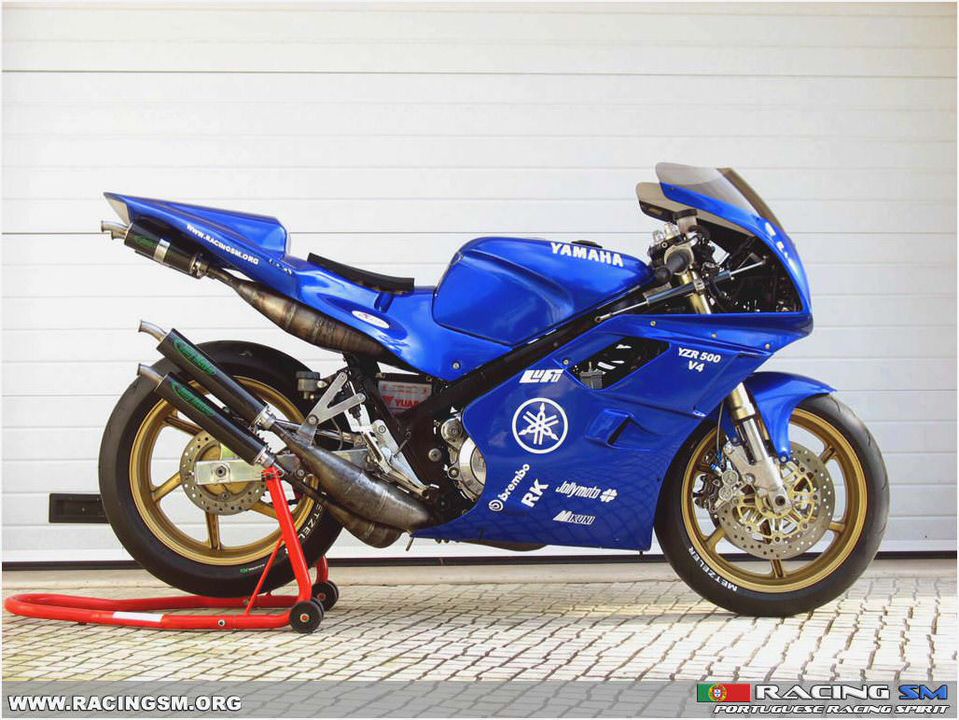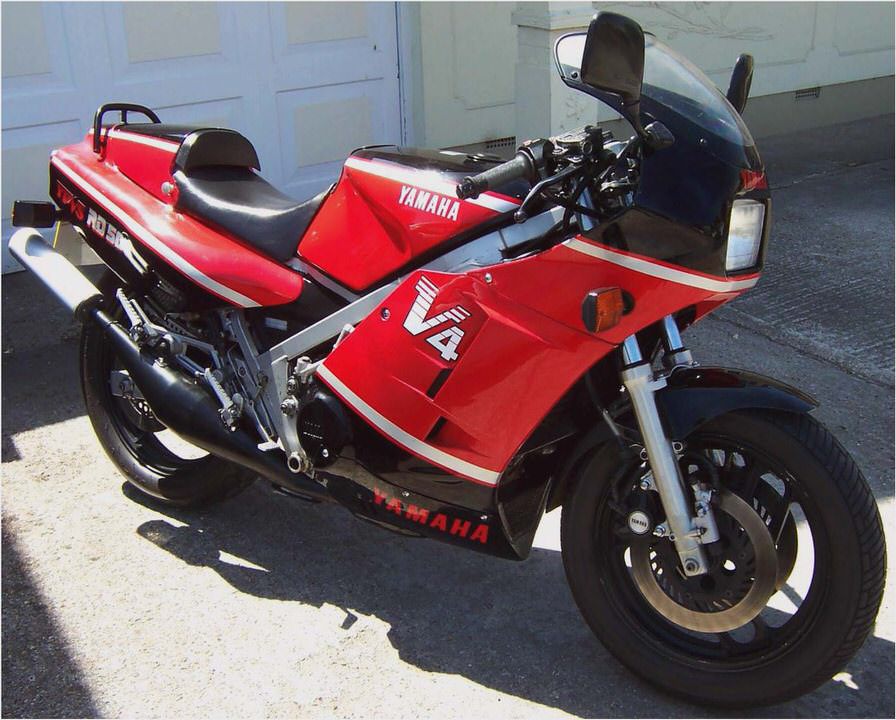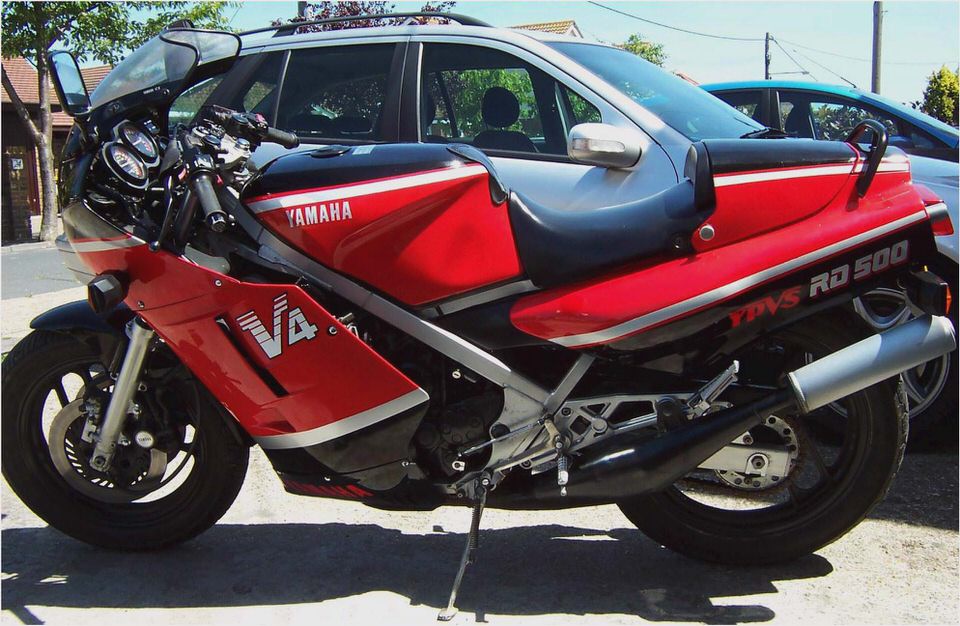
Street going two-strokers died in 1979 right. The Yamaha RD400 failed to return with the geese in the spring of 1980, and that was that. Extinct.
When the water-cooled RD350LC appeared, first in Canada and then in the United States, it wasn’t an authentic rebirth just a cameo appearance for those few dedicated RD-lovers, right again? And the juggernaut of popular preference for big four-strokes rumbled ahead uncaring. Two-strokes were still dead.
Emissions had killed them once, public lust for big four-strokes had killed them twice, and now the grass was green on the grave.
Two-stroke technology didn’t die – it just wasn’t seen on the street-bike side of the showroom floor. What about those torque-laden motocrossers, light as air, and factory road racers with wonderful 4000-rpm powerbands and the BMEP of a good four-stroke? Yes, there was progress aplenty, but it was invisible to pavement riders.
On the other hand, every scrap of four-stroke streetster progress was instantly on sale and ready for immediate delivery. Now how about all that unexpressed, bottled-up two-stroke progress? What kind of street bike would all that make?
Don’t tax your imagination. Yamaha has now built the RZ500.
This hot pipe dream come to life is pretty much a road-going replica of the factory Yamaha OW80 now leading the 500 road racing World Championship. Like the OW, the RZ has an aluminum chassis, a V-four, two-stroke, water-cooled, reed-valve engine, a sideloader gearbox, Power Valve cylinders, magnesium side cases, and, above all, the look of the $1000-a-pound missile which rolled so very carefully to European start grids.
Pipes jutting from everywhere, aluminum mufflers, eye-trapping detail in the footpeg plates, alloy foot controls, streamlining in team paintwork. Food for the eyes, sustenance for the imagination.
And not available in the stores. At least not here, not yet. What are Yamaha’s intentions? Unknowable right now. Let’s not ask. Let’s gaze upon the parts.
The RZ500 is light and powerful 413 pounds dry and near 90 bhp. When the technology went in, the weight came out out of every part. Road racing over the last five years has been a hothouse of design competition, producing not only innovation but also attention to detail making earlier work look coarse. Engineers questioned every use of material in this machine.
Fasteners are down-sized. Thinwall castings abound. Traditional parts have oozed into new forms just a bit lighter, easier to make accurately, and better in function. The result is a street motorcycle weighing only about 100 pounds more than its parent racer. See this forged aluminum kick-start lever folded shyly away behind the fairing?
It weighs nothing in comparison to the steel part on the old RDs. And just as on the real racers, covers have the official MAGNESIUM cast into them for the skeptical.
The engine’s architecture is pure road race. Two cranks each drive the big clutch gear directly without any heavy, power-consuming jackshaft. Between them is a balancer shaft, all three capped by the cover casting carrying the four separate Power Valve cylinders.
Below, the gearbox inserts into the main casting from the left, echoing the quick-change gearboxes of current GP bikes.
The forward pair of cylinders lies horizontal, the rear pair inclines forward at about 20 degrees from vertical. The intakes enter from the vee while one pair of exhausts shoots straight back from the rear cylinders and the other sweeps up from beneath the engine.
The 56.25mm iron-linered cylinders are secured to the crank-cover casting by their base flanges, not by through-studs. This gives maximum freedom for generous transfer port layout. Because the engine is only two cylinders wide, the cylinders can sit on the same 112mm centers that give the current TZ250s their giant, sweeping transfer port arches.
The cylinders must be separate castings because of the way the Power Valves are assembled in them, but the conventional circular-squish heads are cast in pairs.
Is this engine just a heavy wedding of two old RD250s? If it were, it would weigh over 160 pounds, but in fact this engine, with its large ignition, is actually ‘ lighter than the 120 pounds of the 1980-81 magnesium TZ500 engine. Detail design has achieved this.
Crank bearings require solid support all the way across, while gearbox shafts need strong carriage only at their ends. This makes it reasonable to put the cranks in one case split with its heavy sections, and to put the gearbox into a shell whose ends are the only parts of substance. Each cylinder stud feeds its stress into a heavy boss that carries it directly to the main bearing saddles, and elsewhere the cases are only thick enough to keep the fluids and gases where they belong.
Thick where they must be, thin where they may be.
Isn’t water-cooling heavy? Each of these cylinders, even with its water-jacketing and Power Valve, is over a pound lighter than an air-cooled RD250 cylinder. Each RZ head (cast in pairs) weighs only one-third as much as the RD parts.
Added up it more than pays for the pump and radiator.
On to the 50mm-stroke crankshafts. Their flywheels are seven millimeters smaller in diameter than the old RD crank’s and two and a half pounds lighter. Surprisingly, they are also lighter than the current TZ cranks. Motocross influence shows in the flywheels, deeply and smoothly scooped out around the rod big-ends.
This provides for balancing better than expensive drilled holes and gives the intake process an inviting space to head for. As on the 350LC, the hollow crankpins are integral with the inner wheels. The con-rod forgings are as economical in design and material use as the TZ parts and turn on silver-plated big-end cages as the racers’ always have.
Five millimeters shorter than the racing parts, they allow for shorter and therefore lighter cylinders.
Motocross also inspired the cast pistons. Instead of the lumpy, mass-production look of the old RD parts, behold the smooth, dense texture of racing parts. The undersides of the wristpin bosses are relieved next to the rod small-end because there is less stress there. Why send extra metal along just for the ride? The keystone top rings are only 1.25mm wide—a figure seen only in racing engines until not so long ago.
The conical upper surfaces of these rings crush and eject carbon as the pistons rock, preventing long-term deposition that might stick the rings. The second ring has the same width but is of rectangular section. Even the wristpins are lighter. The standard 16mm, they now have larger, smoother holes through them.
The old wristpin clips with their tangs have gone, and no one will mind having to use a scribe-point to pull these new ones. No tangs means nothing to break off inside your engine. TZ owners know all about this.
Look down into the crankcases or up into the bottoms of the cylinders and you’ll be struck by the enormous volume there. This hints at the technology that makes this motorcycle possible right now; philosophically this RZ engine is far closer to the latest racing designs than to any past street engine. Much has been learned in the last five years, and most of it is right here.
After 1945, two-strokes were just grubby substitutes for real engines— transportation specials. As certain dedicated fanatics worked with them they shed their dumpy image and emerged as powerful if difficult devices. The first winning designs of the 1950s had powerbands measured in hundreds, not thousands, of rpm.
Later they were built with 10-, 12-, and even 18-speed gearboxes because they desperately needed them.
Ports were small back then, and pumping fresh charge up through them from the crankcase called for high crankcase compression ratios. Even today some people, mesmerized by this idea, mutter about crankcase stutters.
Small ports and high case pressure combined to squirt the mixture out of the transfers so fast it looped through the cylinder and out the exhaust port at every speed but one— peak power—where the fast-moving piston could chop off the outflow before most of the charge had been lost. Good power might result, but only very high up. The simple pipe concepts of that time made the matter worse, offering no apparent solution to the powerband problem.
For street use, the charge-loss problem was solved by using port sizes and timings so restrictive almost no mixture ever arrived in the cylinder so hardly any got lost – those were the days of the five-horsepower 125s.
In time ports got bigger, and designers realized the exhaust pipe was potentially a better and more controllable pump for the fresh charge than was the crankcase. With such better pipes, capable of prolonged and deep suction, it turned out that engines with big, low-compression crankcases had better powerbands and were no less powerful than the best of the older engines. What a lovely discovery!

The more mixture in the case, the more there is for the pipe to draw through the cylinder to scavenge and fill it. Power rises. At lower speeds, the low-pressure case doesn’t squirt its mixture quickly to the exhaust to be lost—it just flows the mixture in slowly so that much of it is trapped and burned for power. The RZ engine has the generous transfer port area, the large-volume crankcase, and the fat, high-suction exhaust pipes of a modern two-stroke racing engine.
Good power, good band width, good economy and moderate emissions are the result.
Years ago, port timings were the big secrets, but after about 1960 everyone settled on figures that have remained essentially fixed. Only the sizes and directions of ports have changed: a racing engine opens its exhaust at about 79-83 degrees ATDC and opens its transfers about 35 degrees later. A sport engine opens the exhaust at 85-90 degrees ATDC and its transfers 25-30 degrees later.
A trials engine may open the exhaust at 100 degrees and transfers 15-20 degrees later.
Blowdown is the timing difference between exhaust and transfer openings, and determines how much time is made available for cylinder pressure (up at 80-120 psi even after expansion by the power stroke) to blow down low enough for transfer flow to begin. At high rpm, the piston moves fast, so adequate blowdown requires long timing, but on the bottom, when the piston is moving slowly, a much shorter timing is adequate too much would only risk charge loss. The Yamaha Power Valve, raising and lowering the top of the exhaust port, is a device for changing this blowdown timing according to rpm: the engine pulls like a racer on the top end and like a trials machine on the bottom—a very nice combination.
When the RZ’s Power Valves are fully open, the exhaust opens at 85 degrees ATDC just as in the old RDs, while at the bottom of the range it is opening at more like 98-100 degrees ATDC. Why the RD-like timing? Remember, this is a street engine, not a racing engine.
It has do to things like be easily ridable, get reasonable fuel mileage, and even pass certain emissions standards one day. It can’t necessarily do all these things with yawning exhaust apertures. The performance advantage over the old RD comes from the size more than from the timing of these holes. The RD’s exhausts were only 32mm wide, but these new ones are a huge 39mm—only one millimeter less than those of the current TZ250 road racer’s.
That’s 70 percent of bore diameter, something we were told even just a few years ago was impossible without ring snagging. Well, Yamaha has built a lot of wide-port MX and road racer engines since those days and has learned a thing or two. Proper port shape is gentler in pressing the rings back into their grooves after the bulging trip across the port, and, ductile ring materials accept this service without snapping.
Transfer ports open a whopping 38 degrees after exhaust opening, so there is plenty of blowdown for 10,000-plus rpm performance here. The transfers, opening at 123 degrees ATDC, are rather late in comparison with racerly numbers of 114-116 degrees, but higher transfers would in turn require higher exhausts, and soon the RZ would just be a pure race engine. Watch the piston move toward BDC; it uncovers only part of the transfer port windows.
This means there is plenty more to come from this engine in the future.
Power from all this huffing and puffing reaches the six-speed gearset through a big wet clutch whose plates have the same dimensions as those of the TZ750 racer. Any engine whose shafts don’t all lie in a single horizontal case split has a gear lubrication problem. How to lube the shafts and gears at the top of the engine?
Submerge those at the bottom and while oil churning losses are bad enough, potentially running to many horsepower, the oil would foam right out the breather from all that gear action. Yamaha’s answer is to put a small Eaton-type gearbox lube pump at the bottom, drawing oil from the sump area around the shift-drum and delivering it in correct quantity to the several meshes. The pump saves far more power than it consumes, for now the transmission is well lubricated without heavy churning loss.
On modern GP road-racing engines a tuner can pull the dry clutch in about five minutes while his helper pulls the lower pipes and drains the gear oil. The tuner pulls the primary cover while the assistant tackles the drive sprocket in another five or 10. Unbolt the door holding the gear cluster into the gearcase and slide the whole thing out shafts, gears, shift-drum, and selector forks. Lay it out on the bench and exchange ratios to tailor the gearbox to the circuit.
In under 40 minutes, the rider is rolling back out with the right ratios. Obviously at the Grands Prix, this capability is essential. The RZ is built in similar fashion, but for a different reason.
A compact V-four cannot be built as a single-case-split engine, so this racing sideloader construction is the most sensible way to carry the gears. Remember, too, that Harley-Davidson motorcycles had this construction for many years before it became popular at the GPs.
The RZ gearbox, rendered in street-bike fashion, has four dogs at each engagement to cut down on backlash, something that street riders have been known to worry about. In racing, three dogs or even two make more sense because the primary goal is strength and quick, certain engagement. Few dogs and big spaces between them give you this, but they also give the backlash that some folk don’t want.
Neither are the RZ’s dogs undercut as those in a real race engine would certainly be. In racing this draws the gears into engagement and keeps them there during hard, clutchless shifting. On the street, this design is not yet accepted.
Truly remarkable, however, are the extremely close ratio separations, almost identical to a pure-racing TZ750’s:



- 2014 Yamaha SR Viper R-TX SEVehicles reviews – Release date Information…
- 2013 Yamaha XJ6 ABS motorcycle review @ Top Speed
- 2012 New Yamaha Tmax Tech Max Scooter Scooters Mopeds
- 2002 Yamaha YZF-R6 Super Streetbike
- Yamaha Fz 16 – Indian Automobile News
